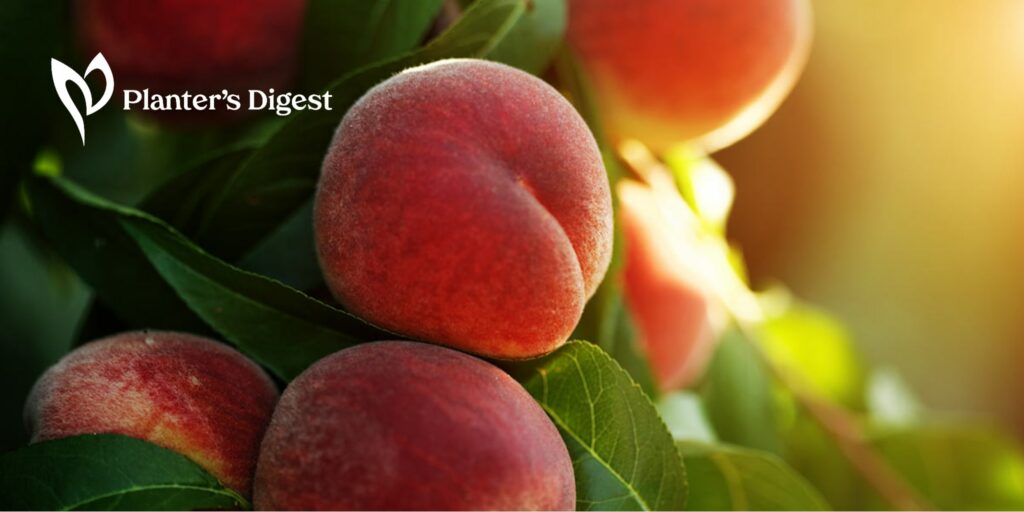Peaches might tease you with their gorgeous blossoms one year and then decide to play hard to get the next. So this begs the question: when do peach trees bear fruit?
A peach tree usually starts bearing fruit 2 to 4 years after planting. Usually, you can expect to harvest peaches from late June to late August in the summer.
Smaller dwarf peach trees can produce fruit a year earlier. Usually, these varieties begin to produce fruit within 1 to 3 years after planting.
Bigger, mature trees yield even more fruit. To make sure your peach tree bears fruit, avoid giving it too much fertilizer, excessive pruning, extremely cold weather, or not providing enough chill hours.
Do peach trees produce fruit every year?
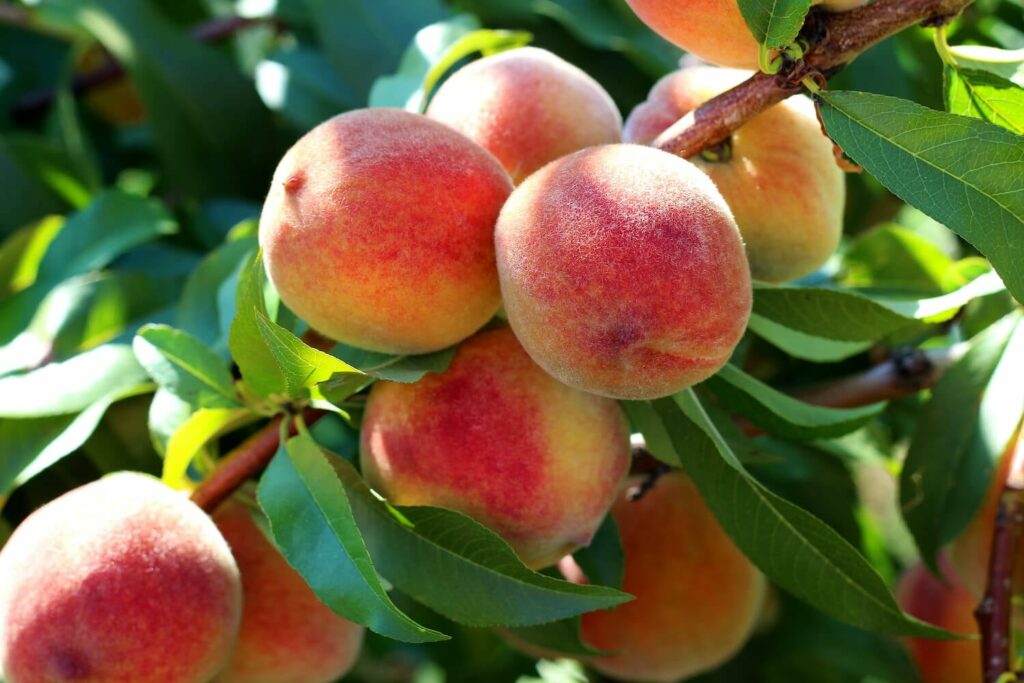
Peach trees typically produce fruit every year under optimal growing conditions. However, note that factors such as weather, disease, and pruning practices influence the consistency of fruit-bearing, so make sure your tree is grown with care.
What month do peach trees bear fruit?
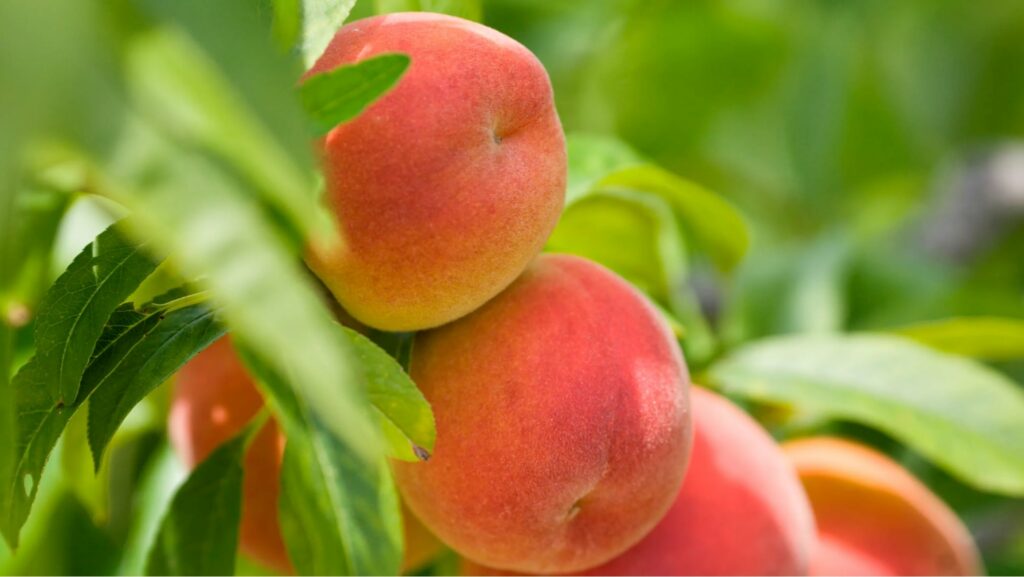
A peach tree can start producing fruit as early as June, but it’s more common to pick ripe peaches in July or August, with some late-season types still bearing fruit into September.
To maximize your peach harvest throughout the summer, it’s best that you plant peach trees that bear fruit at different times. Typically, peaches become ripe about 3 to 5 months after their flowers are pollinated.
Peach trees usually start blooming in March or April. These blossoms are not only fragrant but also come in various colors like white, pink, orange, red, and violet.
While most peach tree varieties can self-pollinate, remember that this doesn’t guarantee successful pollination.
When does a dwarf peach tree bear fruit?
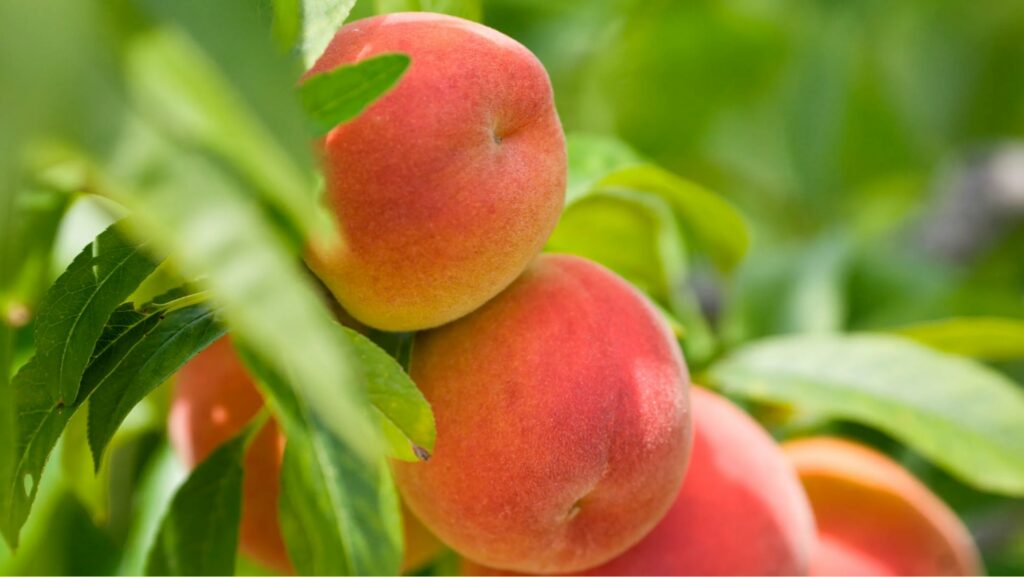
A dwarf peach tree typically starts bearing fruit around two to three years after planting, with the first significant harvest usually occurring in the third or fourth year of growth, depending on the specific variety and environmental conditions.
How much fruit does a peach tree produce?
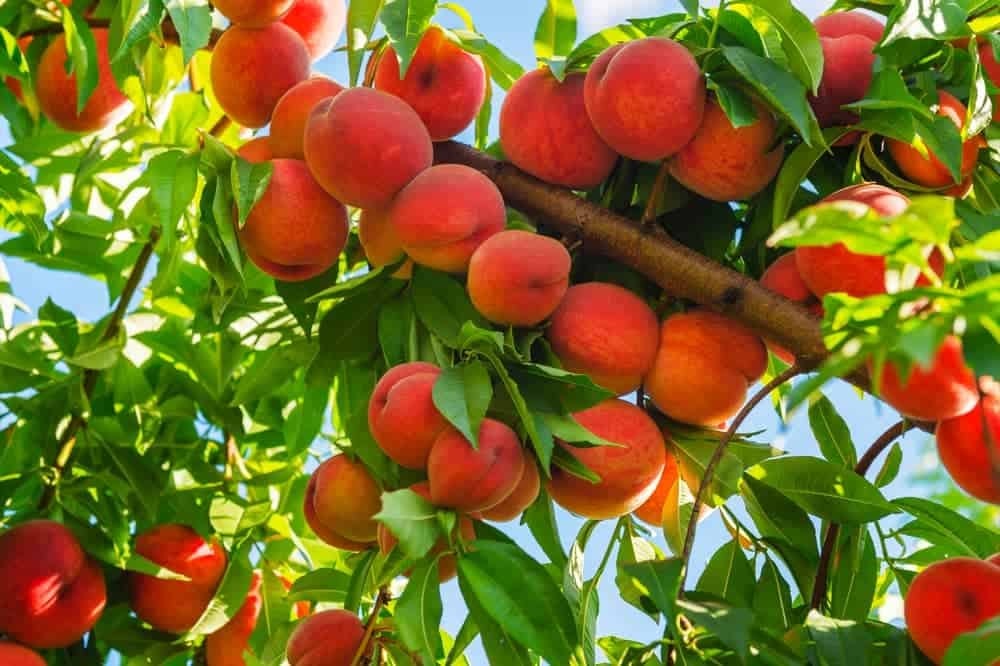
A mature peach tree typically yields 3 to 6 bushels of fruit annually. Dwarf peach trees produce 1 to 3 bushels, while miniature varieties produce up to 1 bushel.
Fully grown peach trees can sometimes yield 150 to 300 pounds of peaches in a year. Dwarf varieties may yield 50 to 150 pounds.
Mature peach trees can continue to bear fruit for over a decade.
What other factors affect fruit on peach trees?
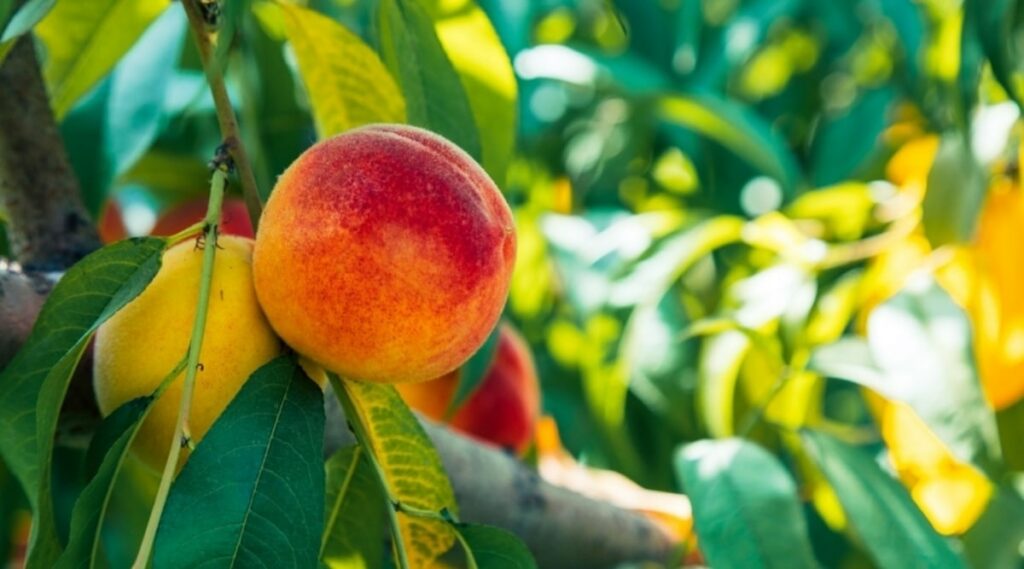
Factors that affect fruit on peach trees are chilling hours, pollination, variety, pruning, thinning, pest control, watering, soil, weather, fertilization, sunlight, and frost protection. Let’s take a quick look at each.
Chilling Hours
Peach trees need a specific amount of cold weather in winter to wake up from dormancy and bear fruit. The required chilling hours vary by peach type, so pick one suitable for your local weather.
Pollination
Peaches depend on pollinators like bees to transfer pollen between flowers. Make sure there’s a healthy pollinator population in your garden to get a good fruit set.
You don’t require two peach trees for fruit production either because most peach types can pollinate themselves. Each flower on a self-pollinating tree has both male and female parts.
Under the right conditions, the male part releases pollen onto the female part. However, self-pollination doesn’t guarantee pollination.
The flowers on most peach tree varieties are self-pollinating, so one tree is sufficient for fruit. However, these flowers still need some kind of stimulus, like a bee’s buzzing or the wind, for proper pollination.
If there aren’t many bees in your area, you can pollinate the flowers by hand. You can use a brush or give the tree a gentle shake to release the pollen into the air.
Variety Selection
Different peach varieties have different fruiting habits and adaptability to your local conditions. Select one that matches your climate, chilling hours, and pollination needs.
Pruning Practices
Keep an open canopy for sunlight and air circulation, promoting fruit-bearing wood and preventing diseases.
Thinning the Fruits
We know it might be painful to think, but it’s something you really have to do. Remove excess fruit early in summer to allow the remaining peaches to grow larger and sweeter.
Pest and Disease Control
Regularly check for pests and diseases and take appropriate measures to protect your tree and fruit.
Watering
Consistent deep watering during the growing season is vital. Mulch helps retain soil moisture.
Soil Quality
Peach trees thrive in well-draining, slightly acidic soil. A soil test can help determine if you need amendments.
Weather Conditions
Weather affects fruit production, whether you like it or not. Protect against late spring frosts and ensure good pollination conditions during flowering.
Fertilization
Maintain the right nutrient balance through fertilization. Keep away from fertilizers that provide excessive nitrogen that can lead to more leaves than fruit.
Sunlight
Peach trees love full sun and they need at least 6 to 8 hours of direct sunlight daily for the best fruit production.
Frost Protection
In frost-prone regions, use covers or sprays to shield blossoms from late spring frosts.
What kind of peach tree should I plant?
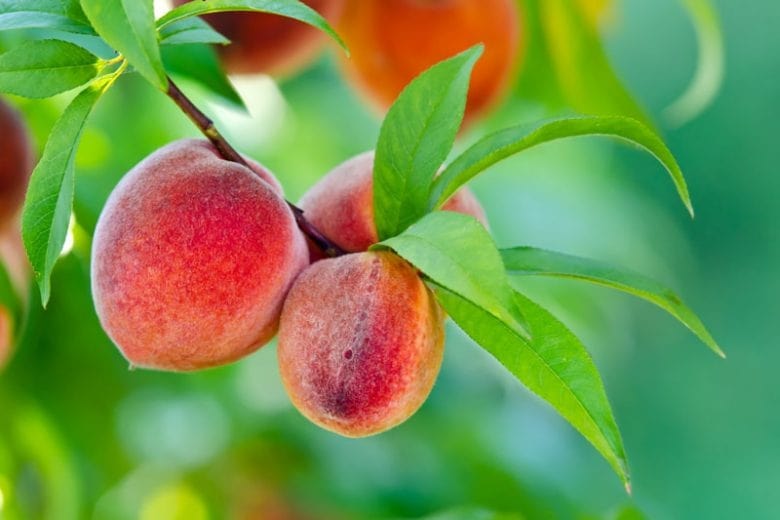
Choose a regular or dwarf peach tree based on space, fruit yield, and maintenance. Regular ones are larger, good for big spaces, while dwarfs suit smaller gardens or containers for easier handling.
Do you need two peach trees to produce fruit?
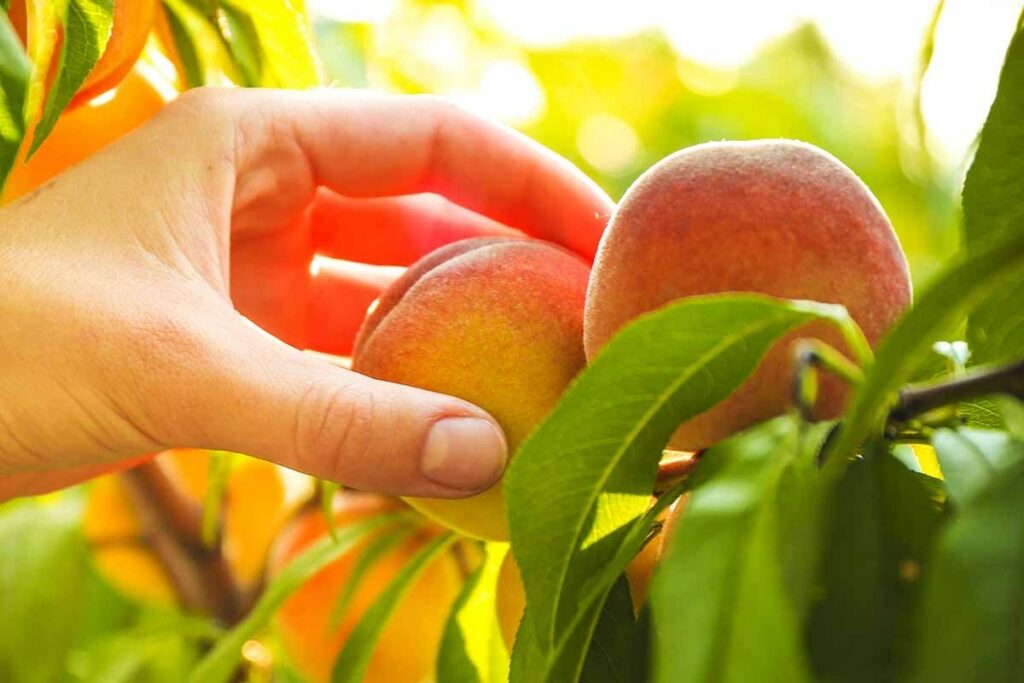
You don’t always need two peach trees for fruit. Some types self-pollinate, but having two can boost pollination and fruit yield.
If you have a self-pollinating tree, it can produce fruit alone, but planting more or compatible varieties improves cross-pollination for better results. Check the peach tree variety and its pollination needs for optimal fruit production.
How long are peaches in season?
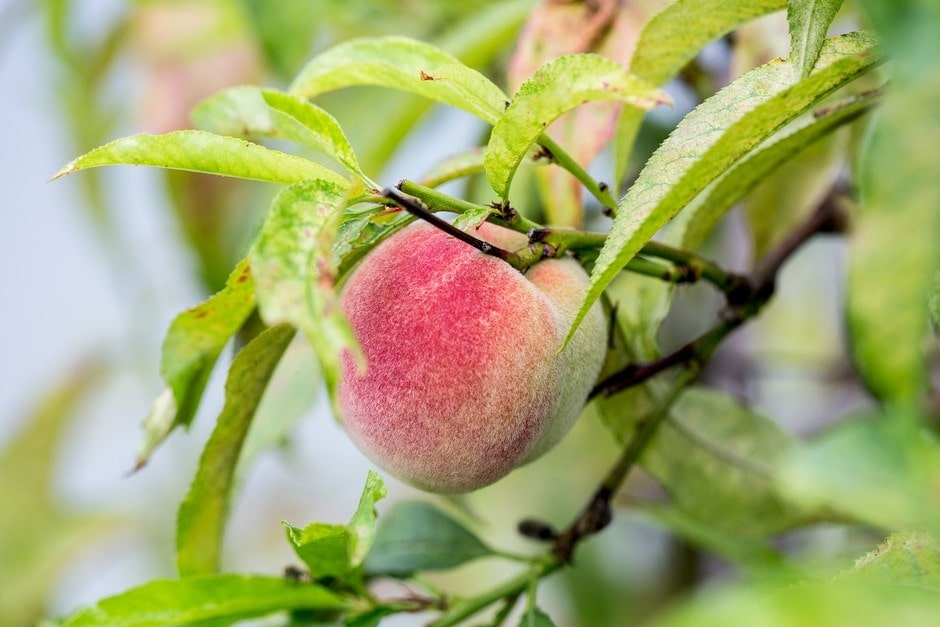
Generally, you can expect fresh, locally grown peaches to be in season from June to September in many temperate climates. However, specific harvest times may differ based on geographical location and local growing conditions.
Peaches are typically in season during the warm summer months, with their peak availability ranging from late spring to early fall. The exact duration can vary depending on the peach variety and regional climate.
What time of year are peaches best?
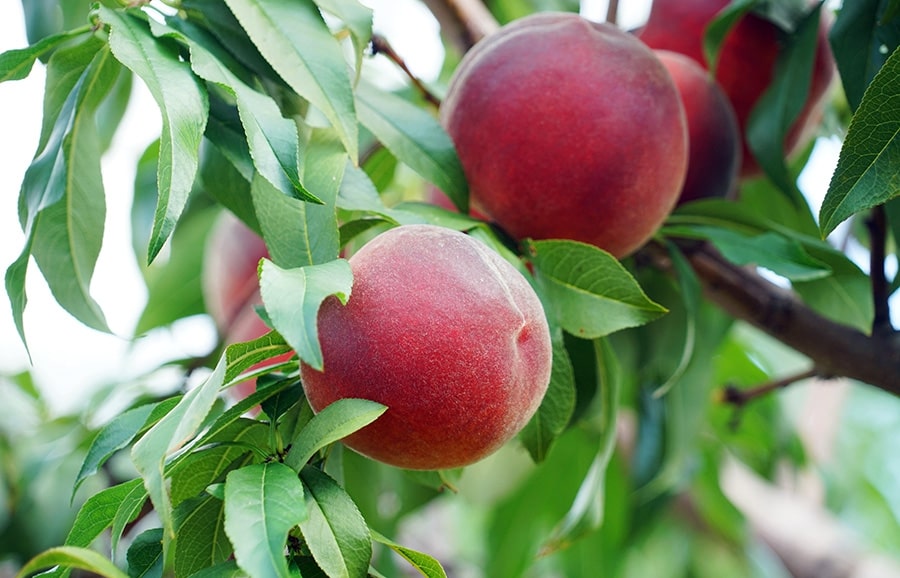
Peaches are best in late spring to early autumn, typically June to September. July and August are peak months, offering the juiciest, sweetest, and most fragrant peaches.
Regular Peach Trees and Recommended Varieties
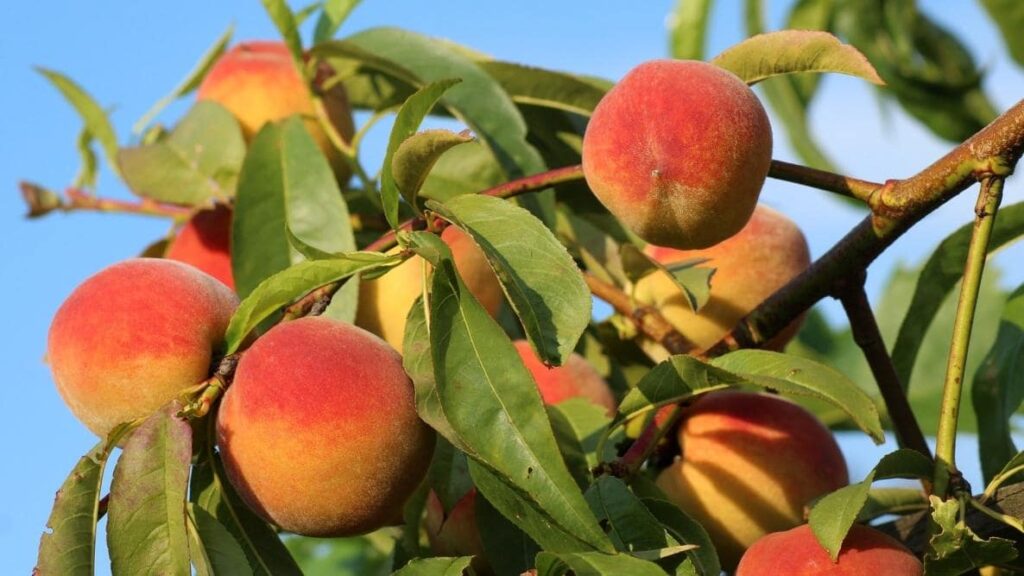
Regular peach trees can grow up to 25 feet or more. If you have the space and a fondness for peaches, these large trees are a good choice.
Regular peach trees typically yield more fruit than their dwarf counterparts. You’ll have plenty of peaches to share with friends, family, and even jealous neighbors!
Bigger trees often produce larger fruits, making your homemade peach cobbler a local favorite. With proper care, regular peach trees can thrive for several decades, becoming a valued part of your garden’s history.
However, it’s not all good news. These trees can be challenging for small gardens as they need room to spread their branches and bask in the sunlight.
Plus, harvesting them can be a bit challenging due to their size. Nevertheless, if you’re thinking of growing some, here are 5 recommended varieties.
Elberta Peach (Prunus persica ‘Elberta’)
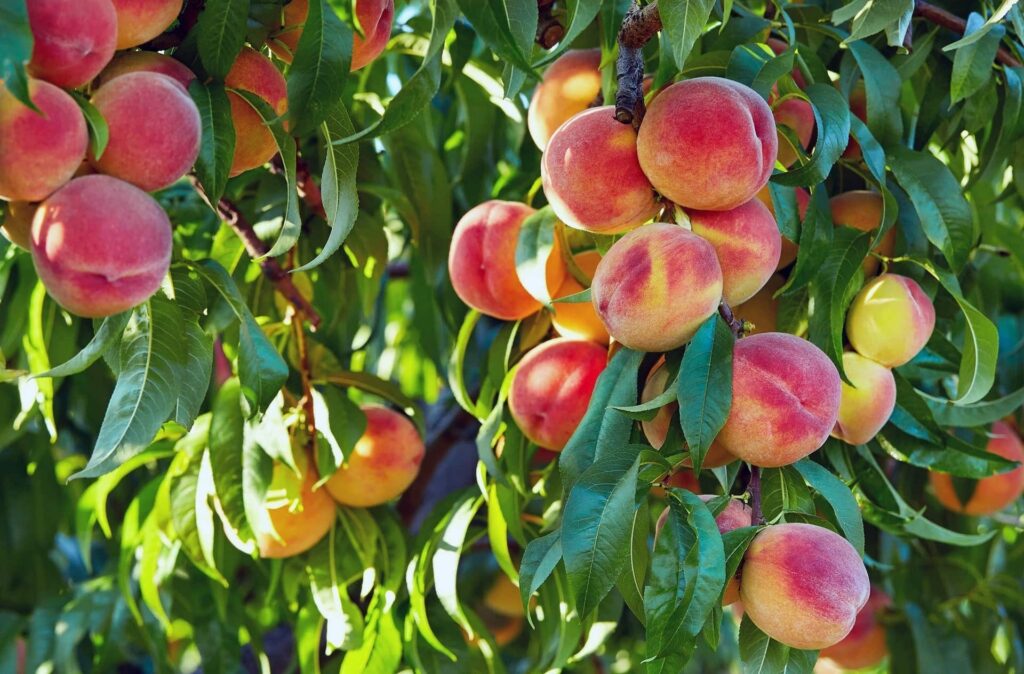
| Factor | Information/Description |
| Ease of Growth | Low to Moderate ●●○○○ |
| USDA Zones | Zones 5 to 9 |
| Climate and Fruiting Season | Warm climates; Late spring to early summer |
| Fruit Size | Medium to large, typically 2.5 to 3.5 inches in diameter |
| Flavor Profile | Sweet and juicy with a classic peach flavor |
| Suggested Companion Plants | Nectarine, plum, apple, apricot, cherry |
Elberta Peach trees do well in soil that drains well and has a slightly acidic to neutral pH, around 6.0 to 7.0 in range. Keep the soil consistently moist, about an inch of water per week during the growing season.
These trees thrive in moderate climates and are suitable for areas with cold winters and warm summers. Make sure they get full sun, at least 6 to 8 hours of direct sunlight daily, for healthy growth and fruit production.
Use a balanced, slow-release fertilizer in early spring to help them grow. Elberta Peaches usually need around 800 to 1,000 chilling hours, which are cold winter hours necessary for flowering and fruiting.
Redhaven Peach (Prunus persica ‘Redhaven’)
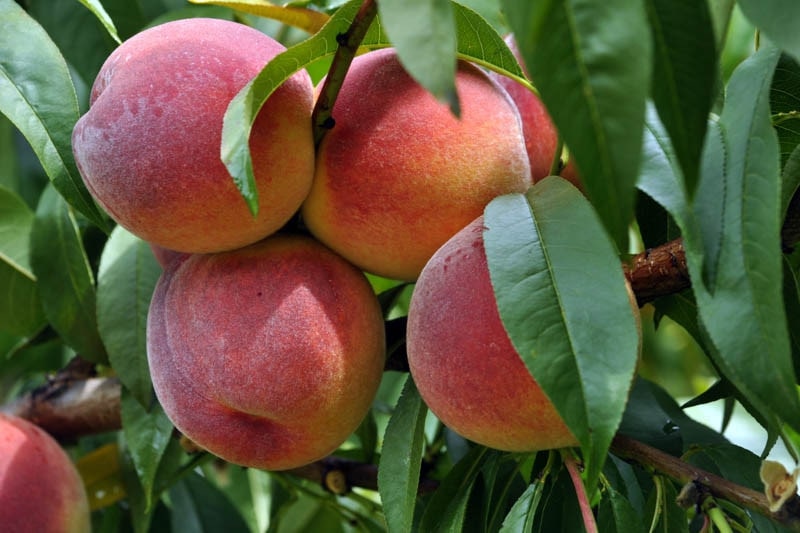
| Factor | Information/Description |
| Ease of Growth | Low to Moderate ●●○○○ |
| USDA Zones | Zones 5 to 9 |
| Climate and Fruiting Season | Thrives in temperate climates; Late spring bloomer |
| Fruit Size | Medium-sized |
| Flavor Profile | Sweet and flavorful |
| Suggested Companion Plants | Apples, pears, and plums |
Redhaven peaches grow best in well-draining soil with lots of organic matter. Go for a pH level between 6.0 and 6.5.
Keep the soil consistently moist for the best growth and water deeply, especially when it’s dry. These peaches can handle winter temperatures between -20 F and 20 F.
Plant them where they get full sun, which means at least 6 to 8 hours of direct sunlight each day. Give them a balanced fertilizer in late winter or early spring to provide the nutrients they need.
Redhaven peaches need about 800 to 1,000 chilling hours, so they’re a good choice for places with cold winters. They’re great for eating fresh, canning, and baking because they have a firm texture and sweet, juicy flesh.
Glowingstar Peach (Prunus persica ‘Glowingstar’)
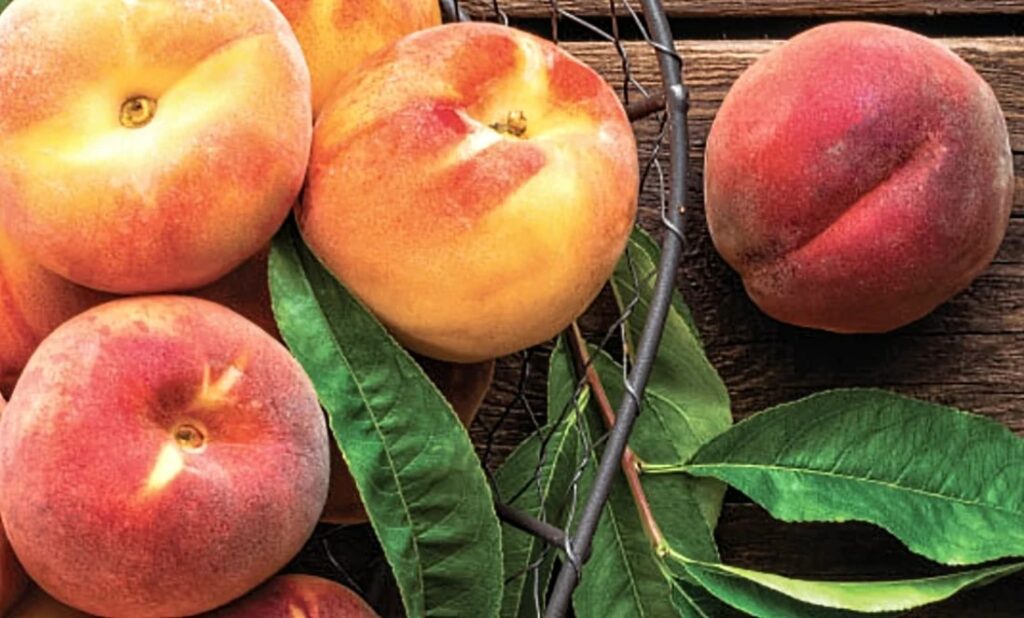
| Factor | Information/Description |
| Ease of Growth | Low to Moderate ●●○○○ |
| USDA Zones | Zones 6 to 9 |
| Climate and Fruiting Season | Warm, temperate; Late spring to summer |
| Fruit Size | Medium to large |
| Flavor Profile | Sweet and juicy with a hint of tartness |
| Suggested Companion Plants | Nectarine, plum, apple, pear |
The Glowingstar Peaches like well-draining, loamy soil so make sure it doesn’t get waterlogged. Keep the soil consistently moist.
Go for an inch of water per week in the growing season. Deep watering is better.
These peaches thrive in temperatures between 75 to 85 F during the day and slightly cooler nights. They need full sun, which means 6 to 8 hours of direct sunlight daily.
Use balanced, slow-release fertilizer in spring. Avoid too much nitrogen, as it can make them grow leaves instead of fruit.
In colder regions, they need about 800 to 1,000 chilling hours in winter for fruit production.
Babcock Peach (Prunus persica ‘Babcock’)
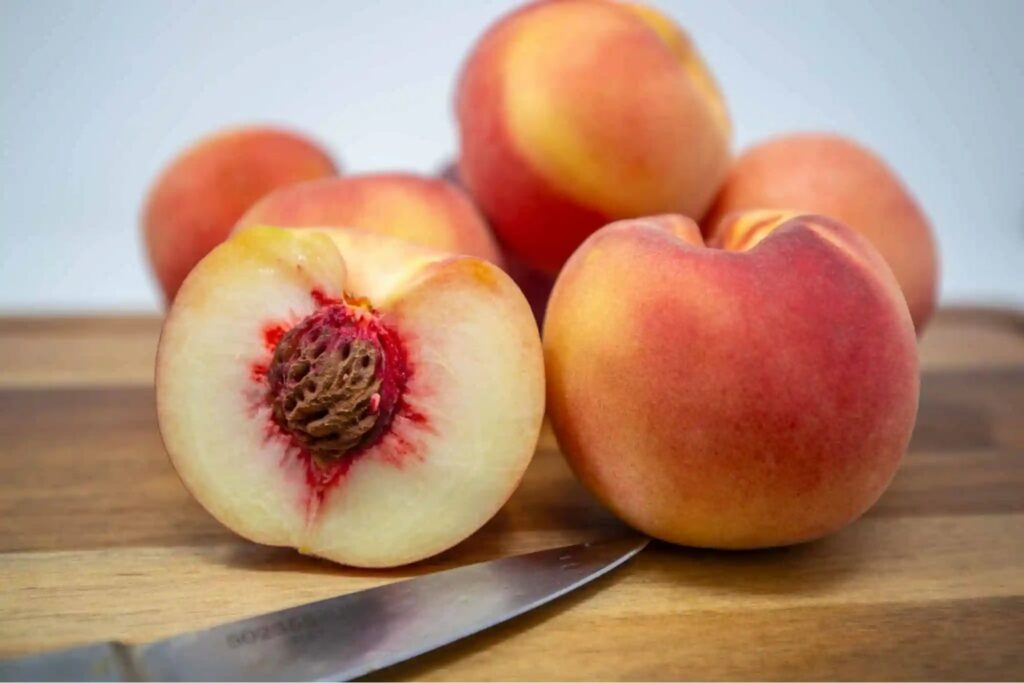
| Factor | Information/Description |
| Ease of Growth | Low to Moderate ●●○○○ |
| USDA Zones | Zones 5 to 9 |
| Climate and Fruiting Season | Warm, temperate; Late spring to summer |
| Fruit Size | Medium |
| Flavor Profile | Exceptionally sweet and aromatic |
| Suggested Companion Plants | Apricot, plum, nectarine, cherry |
Babcock Peaches have sweet, aromatic white flesh, making them a tasty choice. They bear fruit from late spring to summer.
Plant them in well-draining soil, and adding organic matter can help. Keep the soil consistently moist, somewhere around an inch of water per week.
These peach trees thrive in temperatures between 75 F to 85 F during the day and cooler nights. Make sure they get at least 6 to 8 hours of direct sunlight daily.
Use a balanced, slow-release fertilizer in the spring, avoiding too much nitrogen. They typically need 200 to 300 chilling hours during winter to bear fruit.
Hale Haven Peach (Prunus persica ‘Hale Haven’)
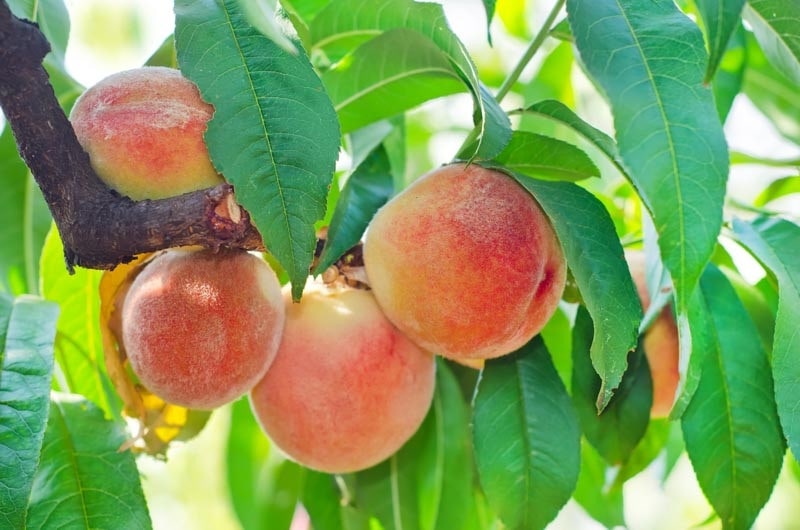
| Factor | Information/Description |
| Ease of Growth | Low to Moderate ●●○○○ |
| USDA Zones | Zones 5 to 8 |
| Climate and Fruiting Season | Warm, temperate; Late spring to summer |
| Fruit Size | Large, round |
| Flavor Profile | Sweet and tangy |
| Suggested Companion Plants | Plum, apricot, cherry, pear |
Hale Haven Peaches are well-known for their large, round, and delicious fruits that often come in abundance. Plant Hale Haven peach trees in well-draining, loamy soil to encourage good drainage and healthy roots.
Keep the soil consistently moist, providing about an inch of water per week during the growing season. These trees like daytime temperatures between 75 to 85 F and cooler nights.
Make sure they get full sun, at least 6 to 8 hours of direct sunlight daily for the best fruit production. Use a balanced, slow-release fertilizer in the spring, avoiding too much nitrogen so that the trees are encouraged to fruit.
In cooler regions, make sure the trees get 500 to 800 chilling hours during winter to set fruit.
Dwarf Peach Trees and Recommended Varieties
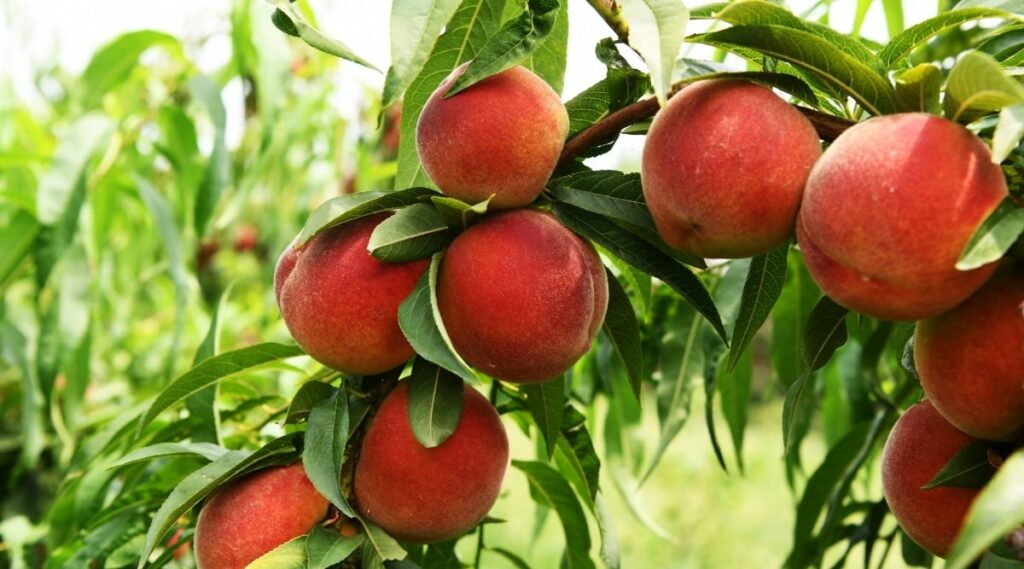
Now let’s talk about dwarf peach trees. They’re usually only 6 to 8 feet tall, great for small gardens or even container gardening.
If you have limited space, these trees fit your decorating and culinary needs perfectly. You won’t even need ladders or gymnastics to reach the fruit as it’s all within arm’s reach.
Plus, dwarf peach trees tend to bear fruit sooner, so you’ll enjoy peaches earlier.
While efficient, dwarf varieties typically produce fewer peaches per tree. These peaches are perfectly snack-sized but not ideal if you’re hoping to make large pies.
Bonanza Dwarf Peach (Prunus persica ‘Bonanza’)
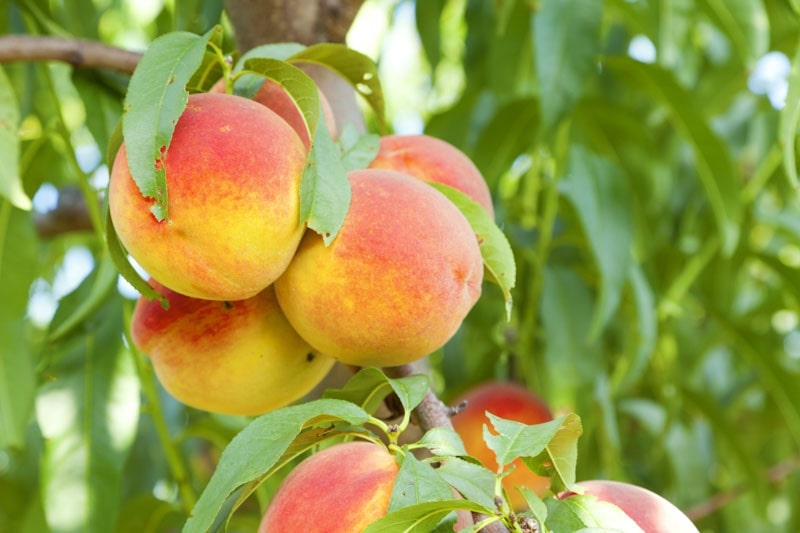
| Factor | Information/Description |
| Ease of Growth | Low to Moderate ●●○○○ |
| USDA Zones | Zones 5 to 8 |
| Climate and Fruiting Season | Warm, temperate; Late spring to summer |
| Fruit Size | Small to medium |
| Flavor Profile | Sweet and exceptionally juicy |
| Suggested Companion Plants | Other dwarf fruit trees, strawberries |
The Bonanza Dwarf Peach is perfect for small spaces, like gardens, patios, or balconies, and can even grow in containers. Use well-draining, slightly acidic soil. And make sure that there’s good drainage when using pots.
Keep the soil consistently moist, especially during dry spells. Don’t overwater.
This dwarf peach tree variety prefers daytime temperatures of 75 to 85 F and cooler nights. Full sun, meaning 6 to 8 hours of direct sunlight daily, is important for growth and fruiting.
In spring, use a balanced, slow-release fertilizer, and avoid excessive nitrogen. Think about planting other dwarf fruit trees or strawberries nearby.
Tropic Snow Dwarf Peach (Prunus persica ‘Tropic Snow’)
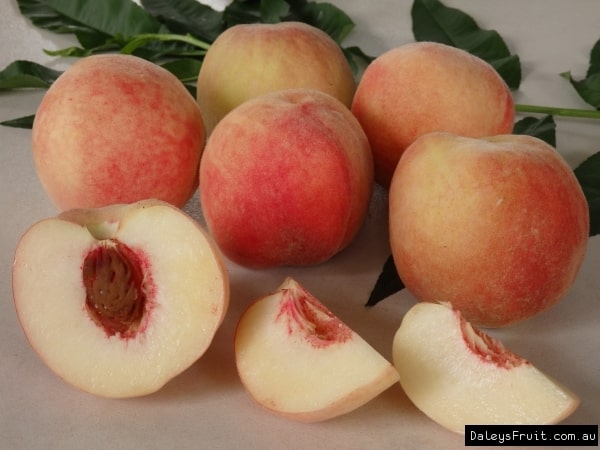
| Factor | Information/Description |
| Ease of Growth | Low to Moderate ●●○○○ |
| USDA Zones | Zones 5 to 9 |
| Climate and Fruiting Season | Warm, subtropical to temperate; Late spring to summer |
| Fruit Size | Medium |
| Flavor Profile | Sweet and slightly tangy |
| Suggested Companion Plants | Nectarine, apricot, cherry |
The Tropic Snow Dwarf Peach is a white-fleshed peach variety known for its sweet, slightly tangy taste. It’s perfect for small gardens or sunny patios.
Use well-draining, slightly acidic soil to prevent root rot. Keep the soil consistently moist, providing about an inch of water per week during the growing season.
Go for 70 to 85 F during the day and cooler nights. Make sure that there’s at least 6 to 8 hours of direct sunlight daily to encourage healthy fruiting.
Apply a balanced, slow-release fertilizer in spring, avoiding excess nitrogen. Trim the tree annually to maintain its compact size and promote fruit production.
Garden Gold Dwarf Peach (Prunus persica ‘Garden Gold’)
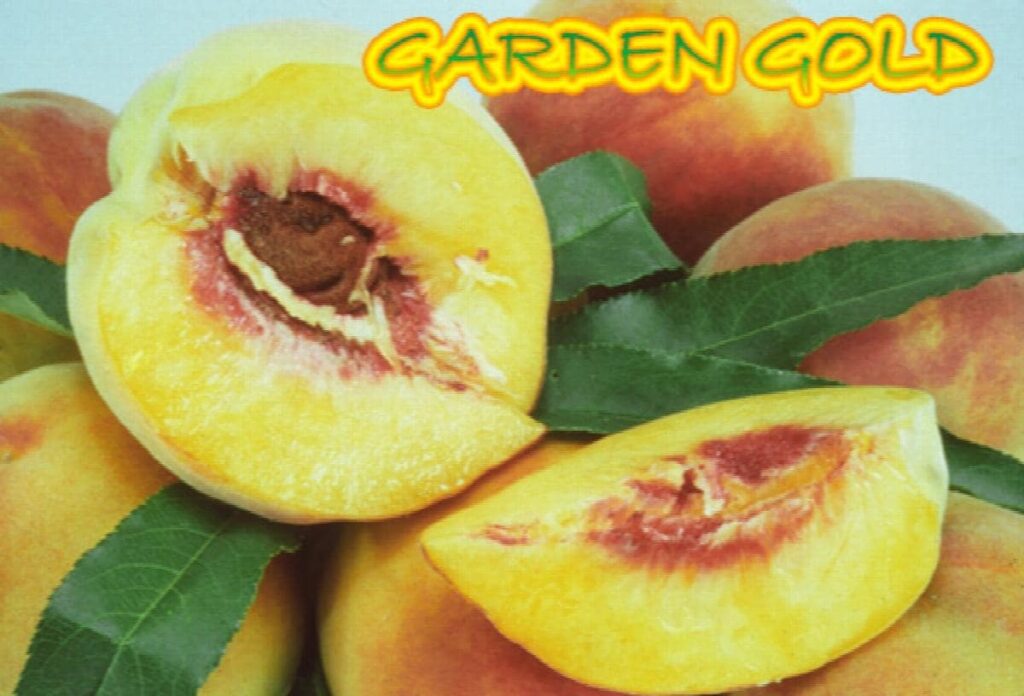
| Factor | Information/Description |
| Ease of Growth | Low to Moderate ●●○○○ |
| USDA Zones | Zones 5 to 9 |
| Climate and Fruiting Season | Mild to warm; Late spring to summer |
| Fruit Size | Medium |
| Flavor Profile | Sweet and mild |
| Suggested Companion Plants | Apricot, plum, cherry, almond |
Garden Gold Dwarf Peach trees like well-draining soil with a slightly acidic to neutral pH level. Keep the soil consistently moist, especially during dry spells.
If you want to make your dwarf peach tree more resilient, then deep watering helps roots grow strong. These trees do best in mild to warm climates but protect them from late spring frosts that can harm blossoms and reduce fruit.
Make sure the tree gets full sun, at least 6 to 8 hours of direct sunlight daily. Use balanced, slow-release fertilizer in spring for healthy growth and fruit. Avoid too much nitrogen.
These trees need around 500 to 600 chilling hours in winter, suitable for various regions. Whether you’re a seasoned gardener or just starting, this easy-to-manage dwarf peach tree lets you enjoy sweet, mild, golden-yellow peaches.
Golden Glory Dwarf Peach (Prunus persica ‘Golden Glory’)
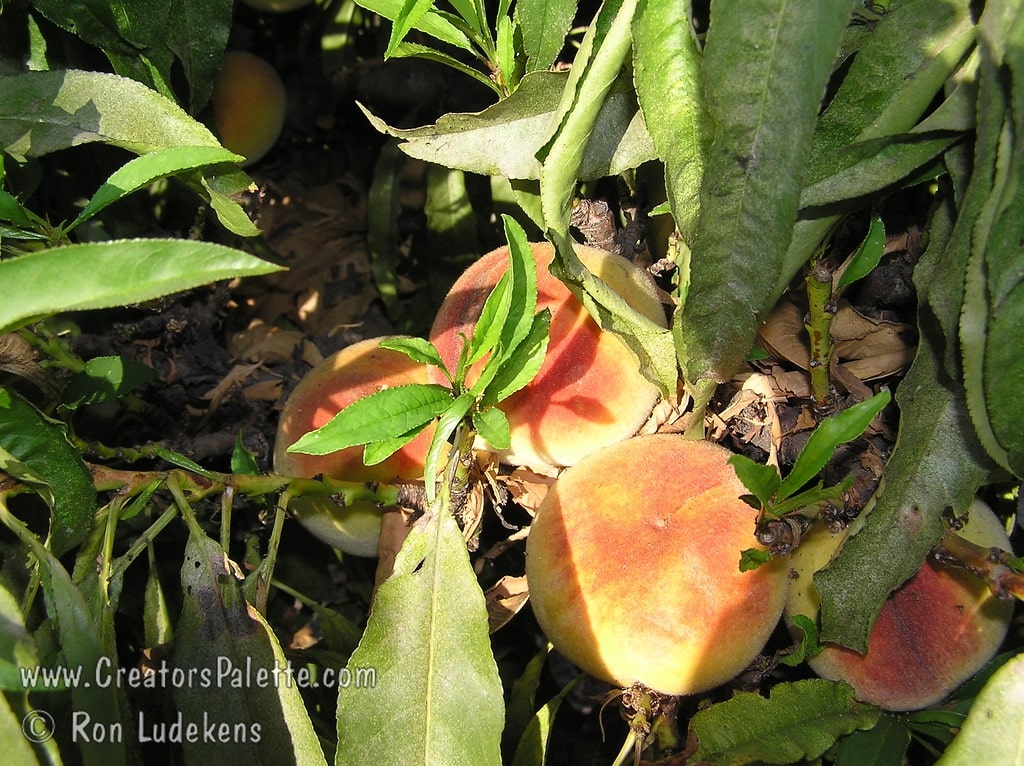
| Factor | Information/Description |
| Ease of Growth | Low to Moderate ●●○○○ |
| USDA Zones | Zones 5 to 9 |
| Climate and Fruiting Season | Mild to warm; Late spring to summer |
| Fruit Size | Small |
| Flavor Profile | Rich and sweet |
| Suggested Companion Plants | Plum, apricot, cherry, apple |
The Golden Glory Dwarf Peach is known for its small size but big, sweet peaches, perfect for eating fresh or making jams. Use well-draining, loamy soil for these trees.
Keep the soil consistently moist but not waterlogged. They’re fine in a range of temperatures but like 70 to 85 F during the day.
Make sure they get at least 6 to 8 hours of direct sunlight daily. Use a balanced, slow-release fertilizer in the spring for healthy growth and fruit.
Peregrine Dwarf Peach (Prunus persica ‘Peregrine’)
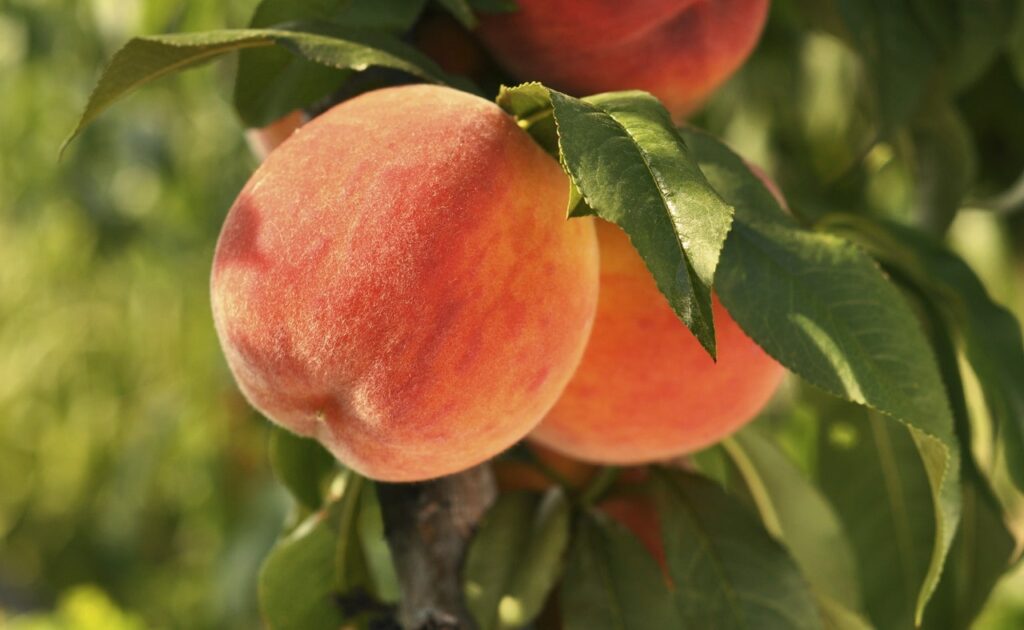
| Factor | Information/Description |
| Ease of Growth | Low to Moderate ●●○○○ |
| USDA Zones | Zones 5 to 9 |
| Climate and Fruiting Season | Mild to warm; Late spring to summer |
| Fruit Size | Medium |
| Flavor Profile | Sweet and aromatic |
| Suggested Companion Plants | Nectarine, plum, apple, pear |
The Peregrine Dwarf Peach is a sweet and aromatic peach variety that’s great for home gardeners, especially those with limited space. Plant in well-draining, fertile soil, and make sure there’s proper drainage especially when placing them in pots or containers.
Keep the soil consistently moist and provide about an inch of water per week. Container trees may need more water than those planted in the ground.
This dwarf variety thrives in temperatures between 70 to 85 F during the day, with cooler nights. Make sure it gets at least 6 to 8 hours of direct sunlight daily.
Use a balanced, slow-release fertilizer in spring in order to avoid excess nitrogen.
Common Reasons for Peach Trees Not Bearing Fruit
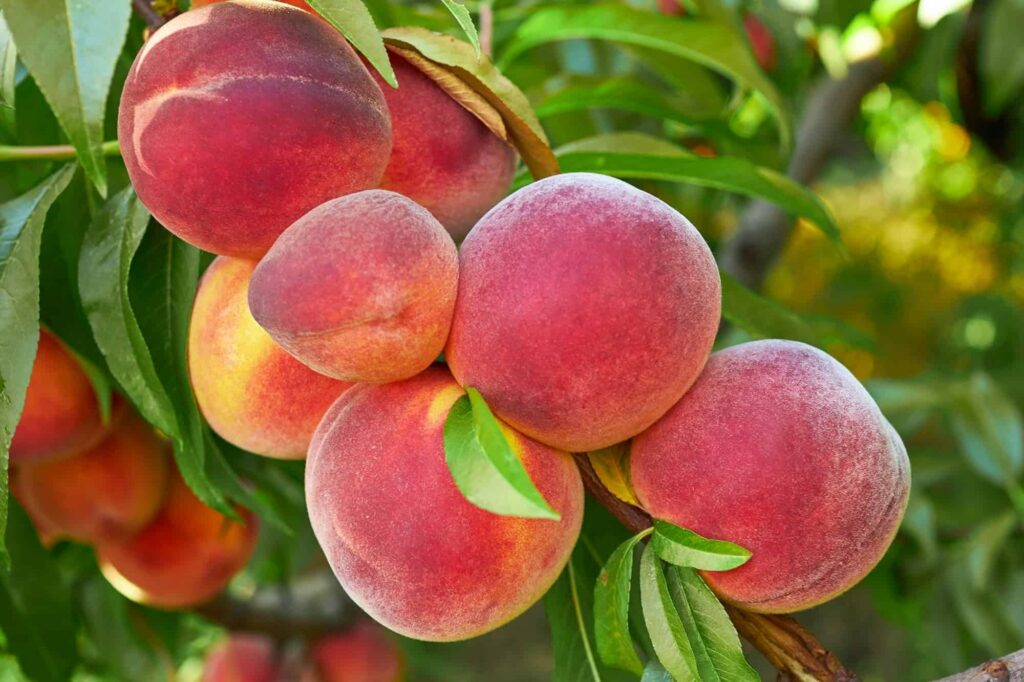
Once the apple of your eye (or should we say, the peach of your eye), may not be yielding the fruity results you anticipated. But before you declare a fruit-growing feud, let’s dig into some common reasons why those peaches might be playing hard to get.
Age and Maturity
Like teenagers, peach trees need time to grow up. Most types start bearing fruit at 2 to 4 years old. If your tree’s still a sapling, patience is your ally.
Frost
Peach blossoms are sensitive to late spring frosts. Sudden cold snaps can zap those delicate flowers, leaving your tree fruitless.
Think about shielding it on chilly nights.
Pollination Issues
Peaches rely on pollinators like bees to transfer pollen between flowers. If your garden lacks these buzzing buddies, it might slow down or even prevent fruit production.
Plant pollinator-friendly flowers to lend a hand. From the top of our heads, we recommend lavender (Lavandula spp.), bee balm (Monarda spp.), sunflowers (Helianthus spp.), coneflowers (Echinacea spp.), and clover (Trifolium spp.).
Pruning Fails
Pruning is important, but going all Edward Scissorhands on your tree can backfire. Over-pruning can remove potential fruit-bearing branches so stick to proper pruning methods for your tree type.
Ignoring Nutrient Needs
Peaches need a well-rounded nutrient diet. Too much nitrogen can spur excessive leaf growth, leaving fruit behind.
Make sure your tree gets the right nutrients in the right doses.
Crowded Roots and Competition
If your peach tree competes with other plants for root space, it might struggle to bear fruit. Make sure it has ample room to stretch its roots and access water and nutrients.
Pest and Diseases
Invaders like aphids or diseases like peach leaf curl can weaken your tree and reduce fruiting. Regular checks and suitable treatments can help ward off these problems.
Unpredictable Weather
Whimsy weather changes can disrupt flowering and fruit-setting. While we can’t control the weather, we can adapt by planting frost-resistant varieties.
Variety Selection
Some peach varieties thrive in specific climates or require particular pollination conditions. Make sure you’ve chosen a variety suitable for your region and garden.
Environmental Stress
Extreme heat, drought, or other environmental stressors can divert your tree’s energy away from fruit production. Proper watering and mulching can ease its stress.


